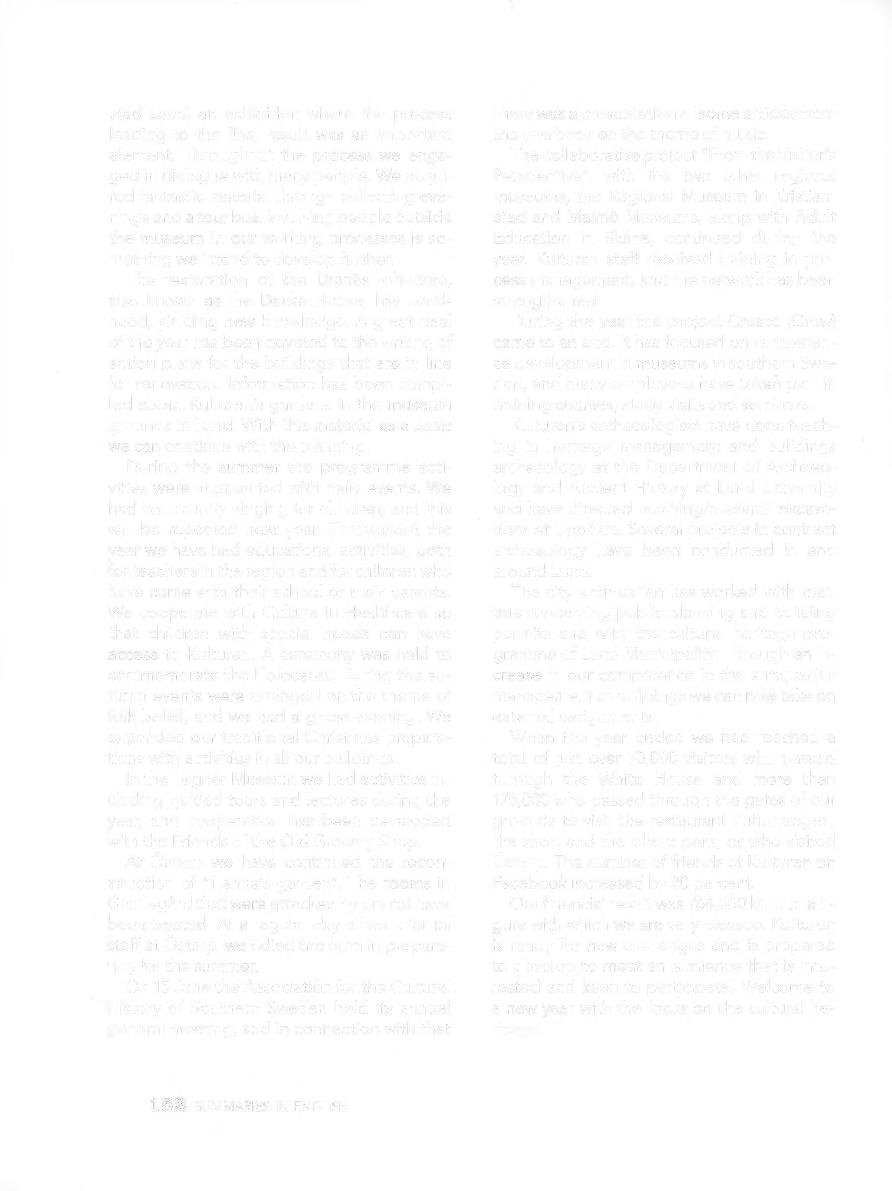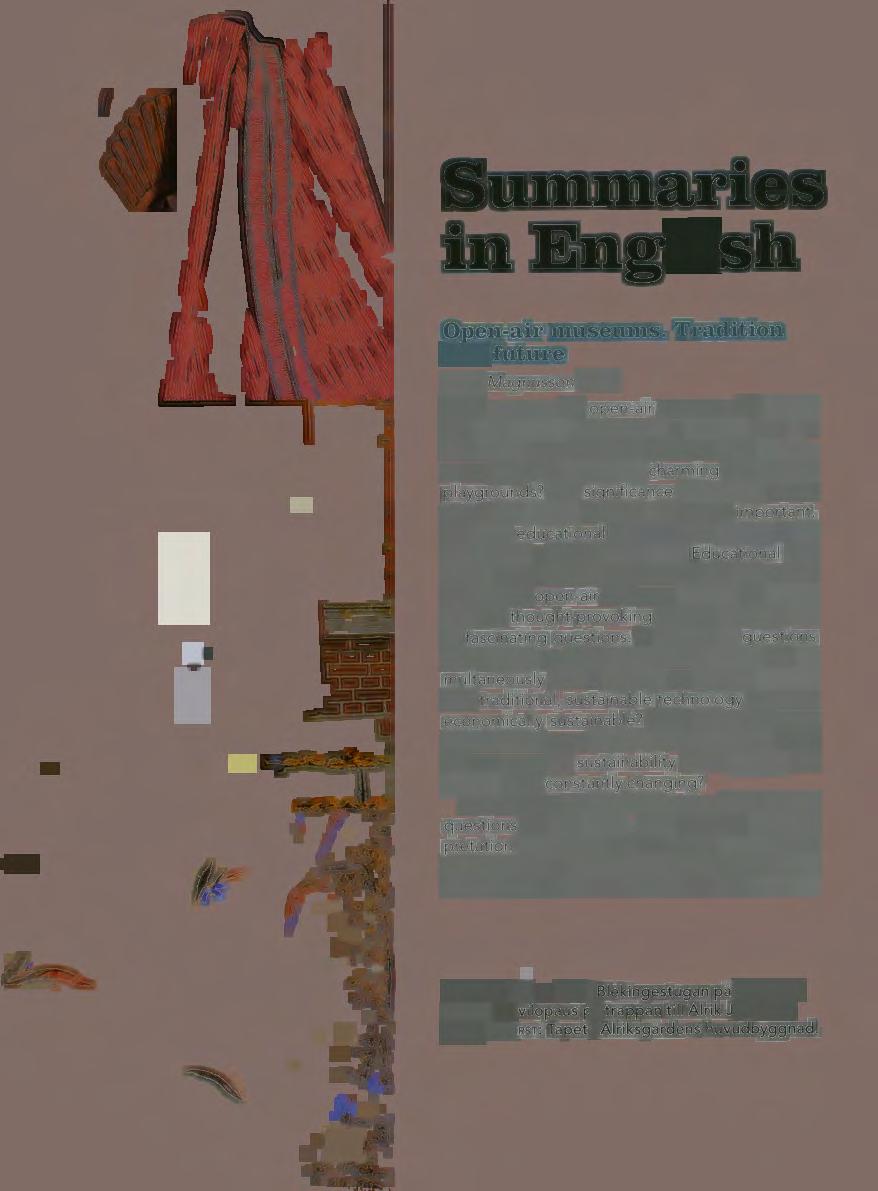
13 minute read
SUMMARIES IN ENGLISH
by Kulturen
Open-air museums. Tradition and future
Björn Magnusson Staaf What purpose do open-air museums fill today? Are they merely remnants of a bygone time -a time when Sweden looked different from today or are they now mostly just charming and exciting playgrounds? The significance of open-air museums in the history of ideas is of course important, but their educational relevance for society is far from being a thing of the past. Educational narratives create encounters between old and new. In this way the open-air museums provide the conditions for thought-provoking insights and give rise to fascinating questions. A number of questions arise, taking us deep into cultural history and simultaneously with a bearing on today's politics: Can traditional, sustainable technology be made economically sustainable? What social and economic needs were satisfied then and now? What do we mean by sustainability when history has proved to be constantly changing?
The answers to these and many other similar questions are not given - they are open for interpretation and debate, but we cannot ignore them. They relate toa living and real world around us, to a future that we and our children will have to live in.
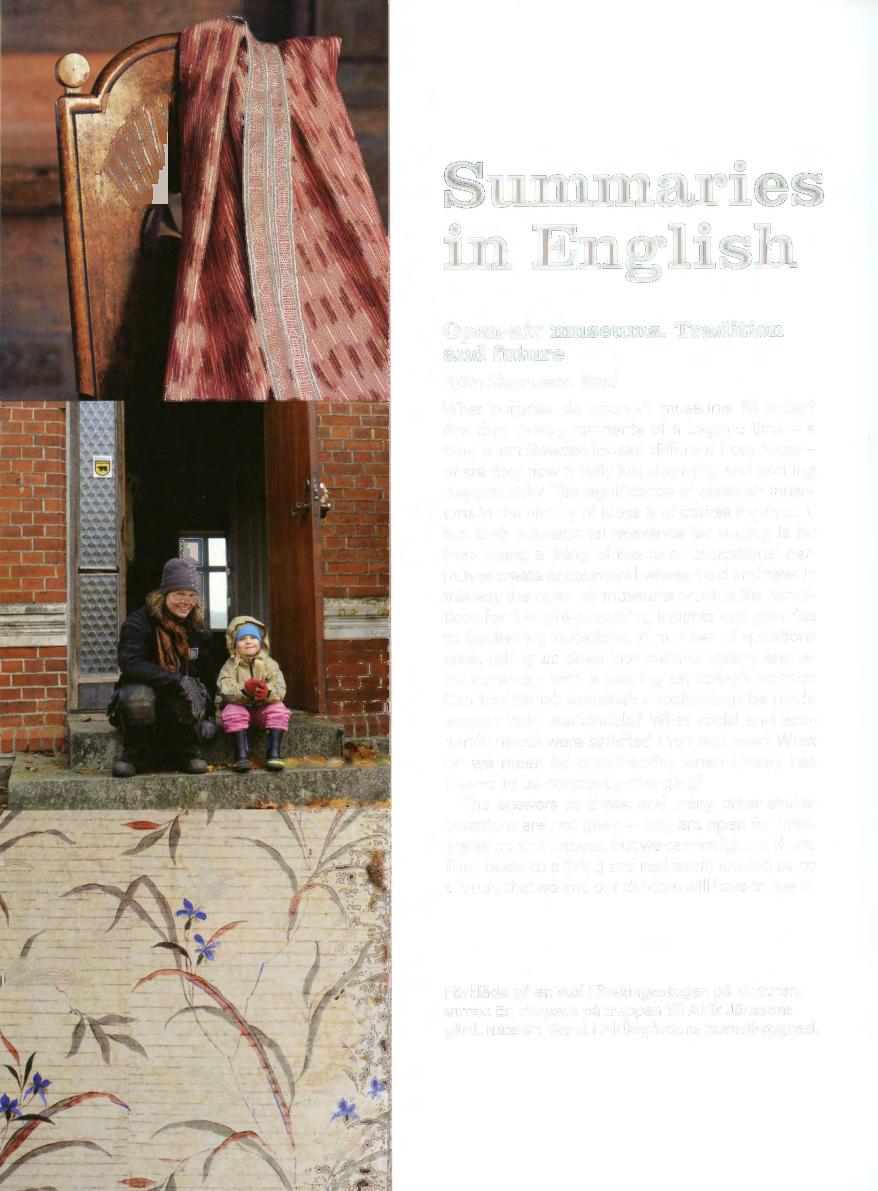
Förkläde på en stol i Blekingestugan på Kulturen. MITTEN: En vilopaus på trappan till Alrik Jönssons gård. NEDERST: Tapet i Alriksgårdens huvudbyggnad.
A race against destruction. On the documentation of peasant culture in the first decades of the twentieth century


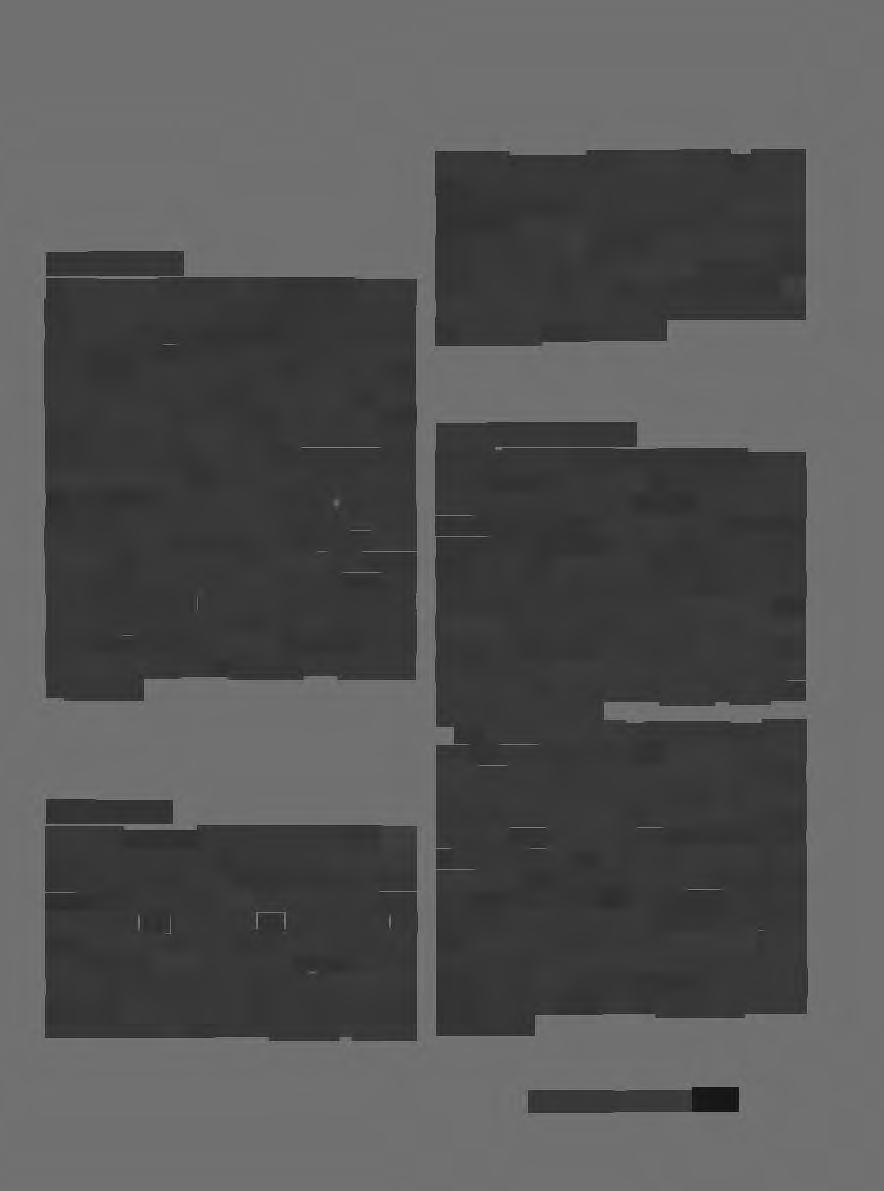
Karin Gustavsson In the opening decades of the twentieth century the vanishing peasant culture was being studied by various Swedish museums and institutions. The state and a number of different organizations were heavily committed to collecting the various expressions of folk culture, such as buildings, dialects, traditions and customs. This was done in the hope that, when the material had been collected by archives and museums, the scholarly analysis and publication could begin. In the 1910s the art historian Sven T. Kjellberg and the ethnologist Sigurd Erixon undertook this task. In the summers they set out on their bicycles to photograph and survey old vernacular buildings. Of particular interest were the "South Götaland" houses in Skåne, Halland, Blekinge and Småland. Several of these buildings were moved to open-air museums. Kulturen, for instance, has an example from Järnshög in Blekinge.
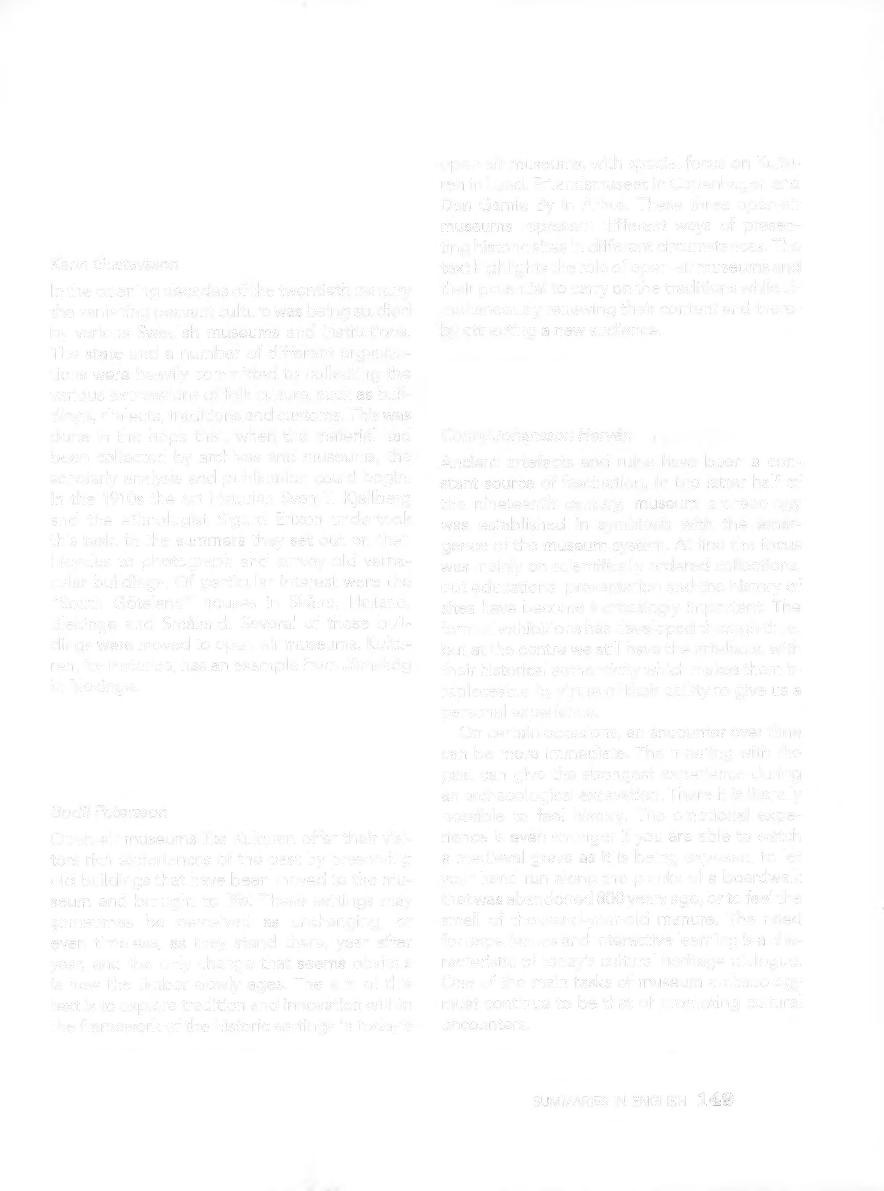
Old times in a new world. Open-air museums between tradition and innovation

Bodil Petersson Open-air museums like Kulturen offer their visitors rich experiences of the past by preserving old buildings that have been moved to the museum and brought to life. These settings may ~ometimes be perceived as unchanging, or even timeless, as they stand there, year after year, and the only change that seems obvious is how the timber slowly ages. The aim of this text is to explore tradition and innovation within the framework of the historie settings in today's open-air museums, with special focus on Kulturen in Lund, Frilandsmuseet in Copenhagen and Den Gamle By in Århus. These three open-air museums represent different ways of presenting historie sites indifferent circumstances. The text highlights the role of open-air museums and their potential to carry on the traditions while simultaneously renewing their content and thereby attracting a new audience.
Unearthed artefacts. Archaelogy in a museum setting
Conny Johansson Herven Ancient artefacts and ruins have been a constant source of fascination. In the latter half of the nineteenth century, museum archaeology was established in symbiosis with the emergence of the museum system. At first the focus was mainly on scientifically ordered collections, but educational presentation and the history of sites have become increasingly important. The form of exhibitions has developed through time, but at the centre we still have the artefacts, with their historical authenticity which makes them irreplaceable by virtue of their ability to give us a personal experience.
On certain occasions, an encounter over time can be more immediate. The meeting with the past can give the strongest experience during an archaeological excavation. There it is literally possible to feel history. The emotional experience is even stronger if you are able to watch a medieval grave as it is being exposed, to let your hand run along the planks of a boardwalk that was abandoned 800 years ago, or to feel the smell of thousand-year-old manure. The need for experiences and interactive learning isa characteristic of today's cultural heritage dialogue. One of the main tasks of museum archaeology must continue to be that of promoting cultural encounters.
SUMMARIES IN ENGLISH 149
Kulturen and the documenters of buildings



Gertie Ericsson At Kulturen a number of people have worked with the documentation of buildings from the medieval and early modern periods. The mode of documentation has changed a great deal over the years. Documentation according to the history of styles prevailed in the days of Georg J:son Karlin and Pär Axel Olsson, but in Ragnar Blomqvist's era it developed to include sources that had previously been ignored, with the aim of understanding how buildings came into being and changed. At the end of the 1960s and up to the end of the 1980s, documentation as done by buildings archaeologists reflected a greater interest in construction and techniques. Whereas the 1990s was largely a time concerned with the methods of documentation and interpretation, development in the present century has mainly dealt with documentation techniques, with emphasis on the importance of digital threedimensional documentation and analysis. In the footsteps of Pär Axel Olsson and Ragnar Blomqvist the archaeological tradition has remained strong at Kulturen, with a united vision of how buildings should be documented and analysed, whether they are preserved above ground or as archaeological remains.

Longed-for gardens

Aja Guldåker In 1890, after many years without a home, the Association for the Cultural History of Southern Sweden was ableto buy a large plotwith a garden and a stone house. The open-air museum was established with cottages and interims from southern Sweden along the old paths in the parklike setting that had been created by the gymnastics master Per H. Ling at the start of the nineteenth century.
Soon the open-air museum was extended with the Lindfors Garden, which added a beau-
150 SUMMARIES IN ENGLISH tiful orchard with symmetrical rose-lined paths, symbolizing the aristocratic environment around the Nobleman's House.
The next major extension took place in 1926, when a large two-family house where the Sjögren and Bonde families had lived was purchased for the Association. An underground passage between the old and the new area partly determined the design of the new area and offered new possibilities for the association's activities. The text tel Is of the structures that survive in the museum grounds from the gardens that existed before the foundation of Kulturen.
A glimpse into the conservation of buildings at Kulturen
Henrik Borg To preserve a building or a site is to preserve a narrative. Kulturen's work of collecting and conserving the material cultural heritage includes the care of the buildings in the museum grounds and out in the surrounding community. Museums have many functions, but one of the most important is to serve as society's memory bank. The physical space, in the form of our landscapes, streets, buildings and gardens, carries memories and stories that can be detected in structures and details. The broader and deeper we can make the memory bank, the better opportun ity we have to ensure that the public debate is more complex, that more people take part, and that we do not hear so many voices advocating simple solutions and advancing arguments with no knowledge of history. The aim is to contribute to society's collective memory and to engage in a debate about our society. An important part of the task is the role of city antiquarian, which includes performing the municipality's longterm work with cultural heritage management, influencing public planning, and taking action in the physical environment. f<ulturen's open-air section has a rich concentration of valuable buildings. These represent the building practices of bygone times, diffe-
rent restoration ideologies, and examples of twentieth-century architecture associated with Lund. Continuous craft-based maintenance is essential for a lasting heritage site. The Uranäs loft-house is used in the text as an example of a major restoration effort undertaken at Kulturen with the museum's own craftsmen.
The garden of dreams. A historical garden in the future



Kristina Bakran The garden at Gamlegård, the main house on Kulturen's farm of Östarp, carries many memories from different times. The person who has left the most numerous and most distinct traces is Hanna Jöns Persson, who lived there between 1850 and 1922. The traces tell us that she was fully aware of the garden ideals prevailing around the turn of the century. Kulturen's ambition is to tend her heritage in the same spirit. The garden at Gamlegård has other layers of time as well, leaving impressions that we can still see today. The history of the garden ranges over several hundred years. The text illuminates the work of reconstructing a garden with many historical layers. It describes the problems and opportunities that can arise when a wild-strawberry patch is recreated. It also examines the sources that can be used to make a reasonable reconstruction and the considerations that are essential in a sensitive environment.
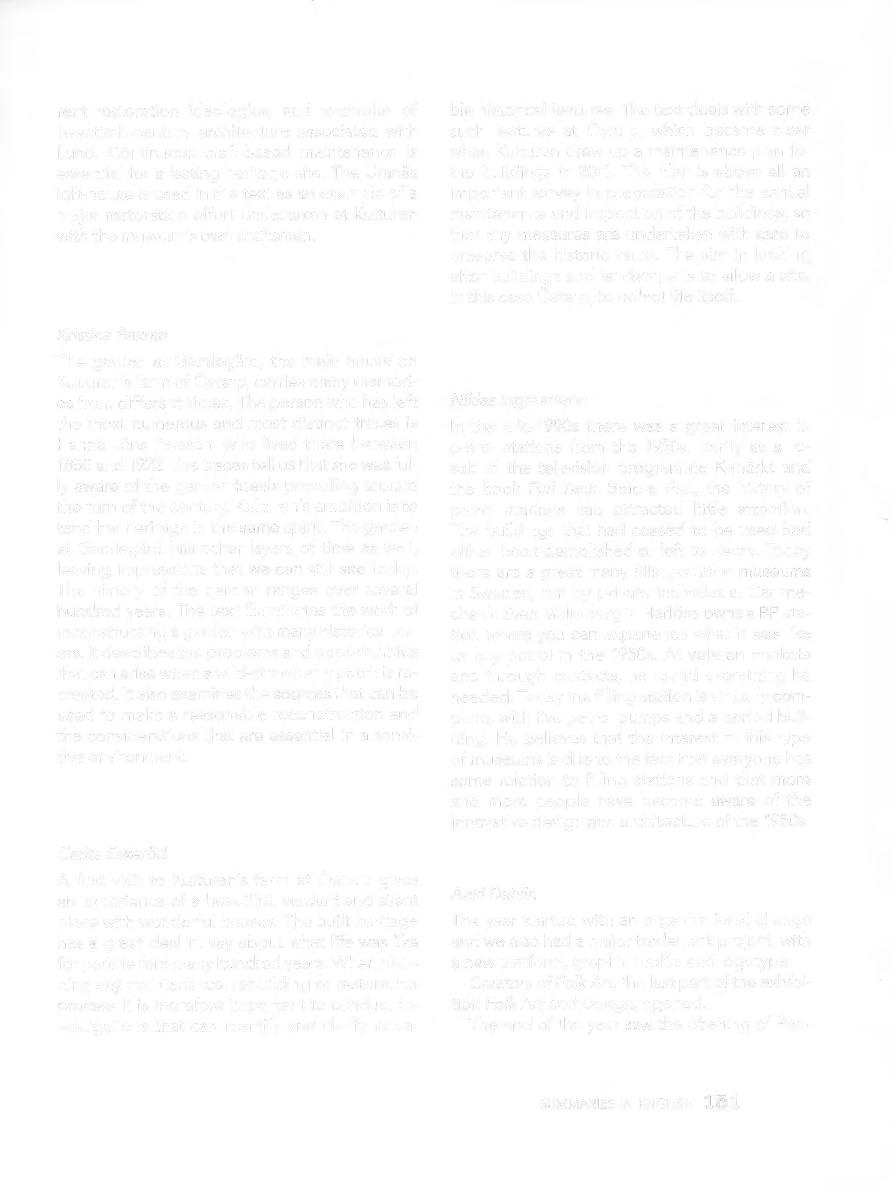
Östarp. The imprint of culture on the landscape

Carita Eskeröd A first visit to Kulturen's farm at Östarp gives an experience of a beautiful, verdant and silent place with wonderful houses. The built heritage has a great deal to say about what life was like for people fore many hundred years. When planning any maintenance, rebuilding cir restoration process it is therefore important to conduct investigations that can identify and clarify valuable historical features. The text deals with some such features at Östarp, which became clear when Kulturen drew up a maintenance plan for the buildings in 2011. The plan is above all an important survey in preparation for the annual maintenance and inspection of the buildings, so that any measures are undertaken with care to preserve the historie value. The aim in looking after buildings and landscape is to allow a site, in this case Östarp, to reflect life itself.
The filling station as an openair museum. A living history
Niklas lngmarsson In the mid-1990s there was a great interest in petrol stations from the 1950s, partly as a result of the television programme K-märkt and the book Full Tank. Before that, the history of petrol stations had attracted little attention. The buildings that had ceased to be used had either been demolished or left to decay. Today there are a great many filling-station museums in Sweden, run by private individuals. Car mechanic Sven Malmborg in Harlösa owns a BP station where you can experience what it was like to buy petrol in the 1950s. At veteran markets and through contacts, he found everything he needed. Today the filling station is virtually complete, with five petrol pumps and a period building. He believes that the interest in this type of museums is due to the fact that everyone has some relation to filling stations and that more and more people have become aware of the innovative design and architecture of the 1950s.
The year 2011
Anki Dahlin The year started with an organizational change and we also had a major trademark project, with a new platform, graphic profile and logotype.
Creators of Folk Art, the last part of the exhibition Folk Art and Design, opened.
The end of the year saw the opening of Pop-
SUMMARIES IN ENGLISH 151
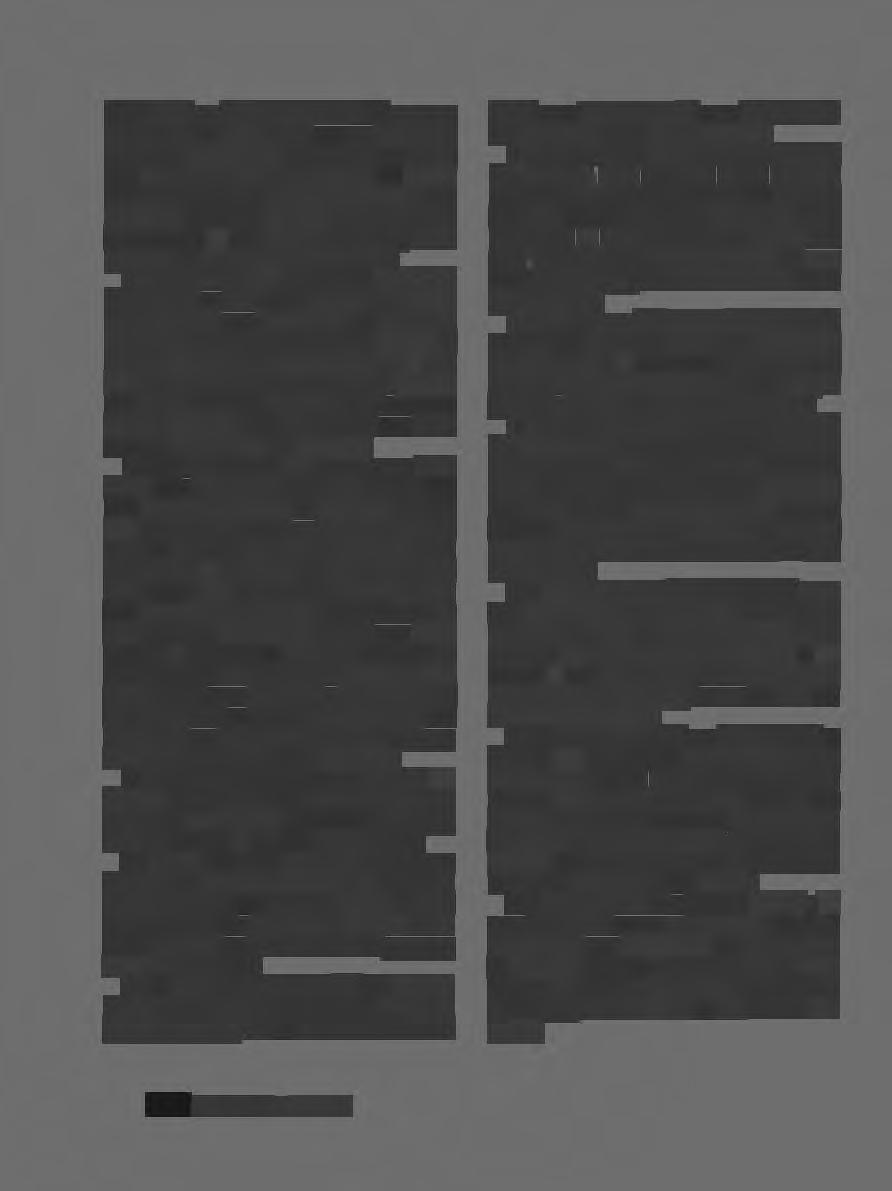
stad Lund, an exhibition where the process leading to the final result was an important element. Throughout the process we engaged in dialogue with many people. We acquired fantastic material through collecting evenings anda tour bus. lnvolving people outside the museum in our working processes is something we intend to develop further.
The restoration of the Uranäs loft-store, also known as the Dacke House, has continued, yielding new knowledge. A great deal of the year has been devoted to the writing of action plans for the buildings that are in line for renovation. Information has been compiled about Kulturen's gardens in the museum grounds in Lund. With this material as a basis we can continue with the planning.
During the summer the programme activities were augmented with daily events. We had community singing for children, and this will be repeated next year. Throughout the year we have had educational activities, both for teachers in the region and for children who have come with their school or their parents. We cooperate with Culture in Healthcare so that children with special needs can have access to Kulturen. A ceremony was held to commemorate the Holocaust. During the autumn events were arranged on the theme of folk belief, and we had a ghost evening. We expanded our traditional Christmas preparations with activities in all our buildings.
In the Tegner Museum we had activities including guided tours and lectures during the year, and cooperation has been developed with the Friends of the Old Grocery Shop.
At Östarp we have continued the reconstruction of "Hanna's garden''. The rooms in Gamlegård that were attacked by dry rot have been treated. At a regular day of work for all staff at Östarp, we tidied the farm in preparation for the summer.
On 1S June the Association for the Cultural History of Southern Sweden held its annual general meeting, and in connection with that there was a presentation of some articles from the yearbook on the theme of music.
The collaborative project "From the Visitor's Perspective", with the two other regional museums, the Regional Museum in Kristianstad and Malmö Museums, along with Adult Education in Skåne, continued during the year. Kulturen staff received training in process management, and the network has been strengthened.
During the year the project Cresco (Grow) came to an end. It has focused on competence development in museums in southern Sweden, and many employees have taken part in training courses, study visits and seminars.
Kulturen's archaeologists have done teaching in heritage management and buildings archaeology at the Department of Archaeology and Ancient History at Lund University and have directed teaching/research excavations at Uppåkra. Several projects in contract archaeology have been conducted in and around Lund.
The city antiquarian has worked with matters concerning public planning and building permits and with the cultural heritage programme of Lund Municipality. Through an increase in our competence in the antiquarian management of buildings we can now take on externa! assignments.
When the year ended we had reached a total of just over 70,000 visiters who passed through the White House and more than 17S,OOO who passed through the gates of our grounds to visit the restaurant Kulturkrogen, the shop and the photo park, or who visited Östarp. The number of friends of Kulturen on Facebook increased by 20 percent.
Our financial result was 764,000 kronor, a figure with which we are very pleased. Kulturen is ready for new challenges and is prepared to develop to meet an audience that is interested and keen to participate! Welcome to a new year with the focus on the cultural heritage.
